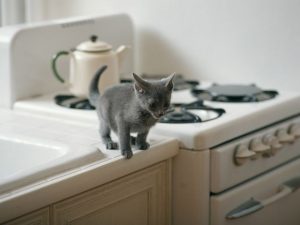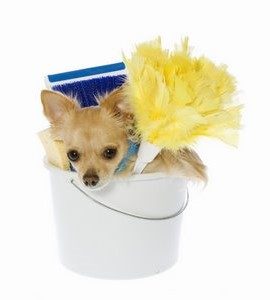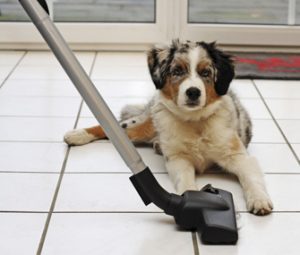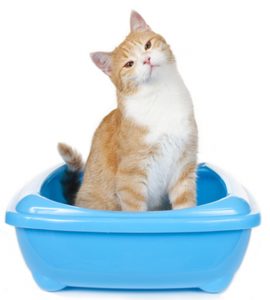Spring Cleaning Pet Safety
April 19, 2017
Spring is here! For many people that also means it’s time for spring cleaning! If you have pets, and are feeling the urge to declutter, deep clean, and spruce up your landscaping, it’s important to consider what products can be toxic to animals and how to keep you pets safe during cleaning time.
 If you’re planning on airing out your house or propping doors open to move out trash or unwanted items, make a plan for your pet! Cats and dogs may not be able to resist the allure of unattended, open doors and windows (especially when there are such wonderful spring time smells outside!) and may take the opportunity to escape. Loud cleaning or landscaping tools like vacuums, leaf shredders, or lawn mowers can also spook pets, so having them safely put away when using those tools will keep everyone safe. Consider closing your pet into one secure room to minimize escape risk. Also make sure that your pet (even your cat!) has identification – a collar and tags and a microchip are best. Check frequently to make sure your pets are where they are supposed to be, and if they have been mischievous and taken themselves out, start looking for them immediately before they’ve gone too far.
If you’re planning on airing out your house or propping doors open to move out trash or unwanted items, make a plan for your pet! Cats and dogs may not be able to resist the allure of unattended, open doors and windows (especially when there are such wonderful spring time smells outside!) and may take the opportunity to escape. Loud cleaning or landscaping tools like vacuums, leaf shredders, or lawn mowers can also spook pets, so having them safely put away when using those tools will keep everyone safe. Consider closing your pet into one secure room to minimize escape risk. Also make sure that your pet (even your cat!) has identification – a collar and tags and a microchip are best. Check frequently to make sure your pets are where they are supposed to be, and if they have been mischievous and taken themselves out, start looking for them immediately before they’ve gone too far.
 Once you get down to cleaning, it’s important to make sure your cleaning products are safe for your pets. Cleaning products can be dangerous for pets in a variety ways- contact with your pet’s paws can cause reactions (including burns), vapors that are barely noticeable to people can be damaging to pets’ sensitive respiratory systems, and ingesting cleaning products is a huge risk of poisoning. Before purchasing or using any cleaning products, make sure to check the product labels for any ingredients that are highly toxic to your pets. The following chemicals are common in cleaning products but are harmful to your pets: Ammonia (found in many de-greasers for ovens, glass and stainless steel), Formaldehyde (found in general household cleaners), Perchloroethylene (found in carpet and rug cleaners), Phenols (typically found in cleaners with “sol” in the name), Phthalates (used in conjunction with scented products, like air fresheners). Pet owners should never use “continuous” or “automatic” toilet bowl cleaners (that latch to the inside of the toilet bowl). These products contain harmful chemicals and if your pet drinks from the toilet (which could be happening even if you’re not seeing it!) could get very sick. If for any reason you think your pet has ingested cleaning products or other toxins, contact the ASPCA’s Animal Poison Control Center at 888-426-4435.
Once you get down to cleaning, it’s important to make sure your cleaning products are safe for your pets. Cleaning products can be dangerous for pets in a variety ways- contact with your pet’s paws can cause reactions (including burns), vapors that are barely noticeable to people can be damaging to pets’ sensitive respiratory systems, and ingesting cleaning products is a huge risk of poisoning. Before purchasing or using any cleaning products, make sure to check the product labels for any ingredients that are highly toxic to your pets. The following chemicals are common in cleaning products but are harmful to your pets: Ammonia (found in many de-greasers for ovens, glass and stainless steel), Formaldehyde (found in general household cleaners), Perchloroethylene (found in carpet and rug cleaners), Phenols (typically found in cleaners with “sol” in the name), Phthalates (used in conjunction with scented products, like air fresheners). Pet owners should never use “continuous” or “automatic” toilet bowl cleaners (that latch to the inside of the toilet bowl). These products contain harmful chemicals and if your pet drinks from the toilet (which could be happening even if you’re not seeing it!) could get very sick. If for any reason you think your pet has ingested cleaning products or other toxins, contact the ASPCA’s Animal Poison Control Center at 888-426-4435.
 There are many pet-safe cleaning products on the market that you can use instead of products with the harmful chemicals listed above. You can also use every day items like baking soda, alcohol, and vinegar for affordable, pet-safe cleaning. Check online for tips and recipes for using those products. Bleach can be toxic to pets in high concentrations and if ingested, but can be safely used as a disinfectant if diluted properly. For a 5.25% bleach (the percent concentration of bleach- sodium hypochlorite- is printed on the product label), a 1:32 dilution is safe. This means for every gallon of water, you can add ½ cup of bleach for effective and safe disinfection. As a general rule of thumb, any areas that are wet or damp from cleaning should be completely dry before your pet has access. If your pet walks or climbs on a wet area, they will likely lick their paws to groom themselves and could ingest remnants of the cleaning product- even if the area has been rinsed with water.
There are many pet-safe cleaning products on the market that you can use instead of products with the harmful chemicals listed above. You can also use every day items like baking soda, alcohol, and vinegar for affordable, pet-safe cleaning. Check online for tips and recipes for using those products. Bleach can be toxic to pets in high concentrations and if ingested, but can be safely used as a disinfectant if diluted properly. For a 5.25% bleach (the percent concentration of bleach- sodium hypochlorite- is printed on the product label), a 1:32 dilution is safe. This means for every gallon of water, you can add ½ cup of bleach for effective and safe disinfection. As a general rule of thumb, any areas that are wet or damp from cleaning should be completely dry before your pet has access. If your pet walks or climbs on a wet area, they will likely lick their paws to groom themselves and could ingest remnants of the cleaning product- even if the area has been rinsed with water.
 Sometimes while cleaning, especially if removing clutter, pet owners may find areas where their pet has soiled in the house. Punishing your pet for potty accidents you just found is not effective, but cleaning them properly will prevent it from happening again! If a pet has had an accident in the house, they are more likely to go back to that same spot again if they are going to housesoil again. While standard cleaners may remove any sight or smell of the mess for your eyes and nose, pets have a much stronger sense of smell. For this reason it is important to use an “enzymatic” cleaner that uses enzymes to break down and remove the acids and pheromones in the urine. Most pet stores sell at least one brand of enzymatic cleaner, and it is worth the small investment to make sure any accident areas are thoroughly and effectively clean!
Sometimes while cleaning, especially if removing clutter, pet owners may find areas where their pet has soiled in the house. Punishing your pet for potty accidents you just found is not effective, but cleaning them properly will prevent it from happening again! If a pet has had an accident in the house, they are more likely to go back to that same spot again if they are going to housesoil again. While standard cleaners may remove any sight or smell of the mess for your eyes and nose, pets have a much stronger sense of smell. For this reason it is important to use an “enzymatic” cleaner that uses enzymes to break down and remove the acids and pheromones in the urine. Most pet stores sell at least one brand of enzymatic cleaner, and it is worth the small investment to make sure any accident areas are thoroughly and effectively clean!
Now that you have all these tips and tools in your belt, it’s time to get out there and start your spring cleaning! Your pets will thank you for keeping their comfort, health, and safety in mind while you tidy up your home- whether inside or out! And while you’re sorting through your items and deciding what to keep or toss, keep in mind that KHS can use many household items! Read more about donating your spring cleaning finds to KHS on our blog. We do ask that used donations be clean and in good working order.



